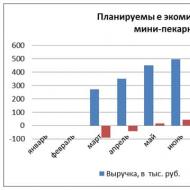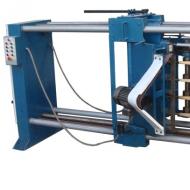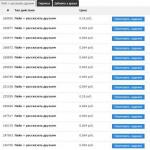
Are native AdSense ad units more profitable than regular ones? Create and configure in-feed ads
This summer, after testing in a limited circle, native ad blocks became available to all webmasters in their AdSense account (they are highlighted in red in the screenshot above).
Ads in the article are intended to be inserted into the text of the article, and ads in the feed can be inserted, for example, on the main page of the site in the list of articles.
I immediately started testing the new format and today I decided to compare the results with regular Google AdSense ad blocks.
The first “regular” block (“Text and display ads”) was located at the very top, right after the title. He had the following indicators:
The main figure here is the average (third) - this is the income per thousand impressions of this block. If anyone is interested, the first number is the number of impressions, the second is the number of clicks, the fourth is impressions in the visible part of the screen, the fifth is the total income from this block for the period under review.
This block was replaced with a native one, i.e. it was inserted between the title and the text of the article, its indicators:
As you can see, the revenue per thousand impressions has not changed at all. There is no need to pay attention to the number of impressions, clicks and total income, since I am comparing different periods of time.
I placed the following block on the main page of the site in the list of recent articles, which I have in the form of tiles:
After replacing this block with a native one (ads in the feed), it turned out like this:
Those. I got a 2x improvement in my block's revenue per thousand impressions.
After replacing it with the native format:
Those. The cost per thousand impressions of the block again did not change at all.
Conclusion
On first impressions, the ads in the feed performed better; by the way, I just like the way they look on the site better. Advertisements in the article show exactly the same results as regular ones. However, on my sites, the regular ads were large, in fact, you had to scroll down to start reading. The new ads, although they show the same result, are more compact - I think this should somewhat improve the user experience of the sites.
You also need to remember that, on the one hand, native formats had a novelty factor and were especially clicked on as soon as they appeared. On the other hand, the entire testing period occurred in the summer, when there was a general decline.
For myself, I decided to leave native formats and return to checking indicators in a few more months.
Let's look at a fairly new (appeared on July 5, 2017) advertising from AdSense - blocks of native advertising in the feed (In-Feed) and in the article (In-Article).
Native advertising is usually more harmoniously integrated into the content and is not striking like standard banners, so, in theory, it has a higher click-through rate (CTR) and, as a result, can increase your income.
We will see whether it will increase income or not, all this needs to be tested, so now I have built one such new advertising block into the middle of each article, and also added the old regular AdSense banner above and below. Let's see which banners will show themselves better, although perhaps the ideal option would be a combination of different formats.
- Provides increased comfort and user experience by using modern elements such as high-resolution images, longer titles, etc.;
- Improved integration with different screen sizes, including mobile and tablet views. Advertising design adapts to the design of your website;
- Easy to use.
New native In-feed ads (in the feed) available to all publishers. They can be placed in lists (sheets) of your articles, products or other items.
Save your HTML template.
Find "
If a given code appears twice, we need the second one.
Replace this code with this script:
The script does not contain any links to third-party sites, I installed it myself and it works.
In July 2017, Google AdSense launched three new native ad blocks for placement on partner sites. I am writing on this topic late, but it is mythical, like the Sirin bird, since I had to check the effectiveness of advertising and then tap on the keys. Testing passed, native ads received 5+ from me, and I will lead the dances from this stove.
Features of ads
Google announced three new formats, but in reality there are two of them, the third existed before, but was not related to the native group. So, today you can use three blocks:
- In-feed
- In-article,
- Recommended content.
The first two advertisements are pure new products, and they needed testing. The Feed and Article blocks are available to everyone; recommended ads are not. On one blog I have recommended content allowed, on the other not, the selection principles are vague, and that’s not the point.
How are the ads different? In-feed blocks are offered for placement in categories with a list of articles or products, but no one forbids placing them anywhere, taking into account compliance with the Google AdSense rules. The main advantage of Feeds is the ability to deeply customize ads. You can change fonts, colors, sizes, photo display features and much more in your account.
In-article ads are automatically customized to fit your site's design and are designed to be placed within content. More precisely, there are settings, but they are minimal. You can only change:
- Heading,
- Description,
I took advantage of what I had and received respect. Be sure to keep the “optimized Google styles” checkbox turned on - without it, things will get messy.
Block efficiency
I chose this layout for my blogs:
- At the top of the In-feed page,
- Under the text In-article,
- Selectively inside the text In-article.
The screenshot shows the effectiveness of ads for 28 days of placing new blocks. We are pleased with the increase in cost per click by 36% and the increase in revenue per thousand impressions by 61%. The numbers are serious. If you look at the blocks separately, I was especially pleased with the In-feed, which I placed at the top of the page. Its effectiveness is even higher by 5-10% compared to a standard adaptive banner. I will explain this by the possibility of deep customization of blocks and their advantageous appearance, compared to a classic banner.

Initially, I installed Google AdSense blocks without changing the styles. The effectiveness turned out to be so-so - the price increased, but the CTR remained virtually unchanged. After that, I changed the styles of the In-feed block and it worked. I also changed the color of the title and description in the In-article block and it also turned out to be a plus.

Hence the conclusion - the ads showed excellent effectiveness on two different blogs (construction site Stroyremontiruy and Zegeberg), but it is necessary to make changes to the design! With the default setting there is practically no respect; growth of 5-10% is not a serious thing.
- In both ads, change the color of the ad headings to match the site headings,
- Save optimized Google styles,
- Leave the default text font color,
- In In-feed, change the button outline to match the site color and keep the long title.
In short, adjust your advertising design to the style of your site as much as possible, take into account the tips above and you will eat chocolate with a dessert spoon. Setting up native blocks will not take much time, and you can rest assured that your advertising income will increase.
Back to the Future, 1985. Universal Pictures.
Native, or natural, advertising (from English. native advertising) - the way in which the advertiser attracts attention to himself in the context of the site and the interests of the user. In the original, it must take into account all the features of the platform, not be identified as advertising and not cause rejection among the audience. Such advertising unobtrusively “awaits” the user where he himself is looking for interesting content. In essence, it is similar to product placement: remember how Marty McFly ran in Nike sneakers in the second part of Back to the Future.
Therefore, the main advantage of native advertising is the ability to “jump over” the mechanical barrier of perception (in other words, overcome “banner blindness”, if we talk about online), which does not allow users to even look in the direction of your advertising, because they are simply tired of it.
Since the 1880s, American consumer product companies have sought to attract customers through advertising campaigns. Advertisements of that time in newspapers and magazines did not shine with originality; they mainly consisted of slogans, appeals and pictures with images of goods. Agencies realized that new types of advertising were needed that would allow them to stand out from the crowd of such advertisements.
An excellent example of the native format of that time is considered to be advertising in The Furrow magazine. In the publication he owned, John Deere (founder of Deere & Company) published feature articles about agriculture and various tips for farmers. At the same time, advertising blocks with information about agricultural products produced by the Dira company were placed on the pages of the magazine. Today, Deer & Company continues the tradition by moving online.
At the beginning and middle of the 20th century, with the development of radio and television, new formats of native advertising appeared. On the radio – sponsorship of broadcasts of radio programs, sports matches with the addition of advertising blocks on air. A striking example of native advertising on television was the broadcast of advertisements for Procter & Gamble products in TV series that were broadcast during the day and later became known as “soap operas.”
With the advent of the Internet, the world has turned upside down. Native advertising has evolved into search ads that directly connect businesses with target customers on search engines. With the arrival of digital media companies (for example, BuzzFeed) on the market, the world of native advertising has turned upside down once again. Such sites almost immediately refused to place banner advertising and placed their main emphasis on sponsored viral content, which helps partner brands convey information about their products to the target audience in an unobtrusive form.
The definition of “native advertising” in the modern digital context was first voiced by Fred Wilson at the Online Media, Marketing, and Advertising Conference in 2011. Traditional news sources - The New York Times, The Wall Street Journal, The Washington Post - eagerly picked up the new trend.
Interestingly, in most cases, publishers claim that they tag native ads, immediately letting the reader know what they are dealing with. However, a study published in June 2015 by Advertising Age found that the most understandable and logical label for users - “advertisement” - is usually not used. Instead, articles are appended with “sponsored,” “promoted,” or “presented by.”
The IAB Native Advertising Playbook identifies six major interactive formats currently used in native advertising:
- paid content that is displayed in the news feed - for example, on Facebook or Instagram;
- advertising in search engines;
- blocks of content recommendations;
- advertisements (direct advertising of goods and services);
- standard IAB advertising with native elements;
- other formats that cannot be included in previous groups and are developed for each specific case separately.
When posted on open platforms, the content is promoted along with the platform, with its assistance, and is not published anywhere else. Examples: Twitter Promoted Tweets, Facebook Sponsored Stories, TrueView Ads, and other YouTube video ads.
Open platforms are different in that the same social media and on the same platforms contain branded content and advertising messages, the source of which is not the platform, but a third-party resource from which the advertising is broadcast.
Native advertising today is one of the most promising formats for mobile application developers. According to eMarketer forecasts, budgets for it will grow by 25% in 2017. This format is already offered by all major advertising networks: Applovin, Avocarrot, Facebook, Flurry, myTarget, Pubnative, InnerActive, StartApp, Mopub and others. This means that developers should now think about how to use native advertising in their projects.
How is native advertising different from other formats?
Native advertising is organically placed in the application and adjusted to its design and context. It looks like part of the application, so it is more informative and generates a higher CTR. In addition, such advertising causes much less irritation to the user - the brain perceives it like any other application content and does not automatically block it, unlike annoying banners.Native advertising in the VFeed app
The main advantage of this format is the ability to create an advertising block yourself. The developer himself configures the size, appearance and location of all fields in the ad. His task is to adapt the design as much as possible and choose the right moment for display, so that advertising becomes an appropriate part of the application.
Ad elements and parameters
Native advertising is not just a banner or video that appears in the application at the right time. In response to each request for advertising, we at Appodeal receive a specific set of data from the advertiser, which will then be displayed in the application in the order specified by the developer. Such data includes: mandatory, and optional elements with their own restrictions.
- Title– ad title, up to 25 characters (required)
- Description – a story about the characteristics of a product or a description of the functions of an application up to 100 characters long.
- Icon– application icon or company logo size from 80*80 to 512*512 pixels*
- Main image– main image depicting a product or application, 1200*627 pixels.
- Call-to-action (CTA)– a button with a call to action. The size of the button and the inscription on it can be any (mandatory).
- URL, to which the ad is redirected - a link to the advertised product or application (required).
- Label “Advertising”– an element that clearly communicates that this is an advertisement. The appearance of the element is determined by the application developer himself, for example, the mark Ads, Sponsored, Advertising, Promoted or Recommended (required).
- Content rating – the permissible age of the product consumer (4+, 12+, 18+, etc.).
- Star rating – rating of an advertised application or product in a store (from one to five stars).
- Some networks, such as Facebook, Avocarrot and Mopub, require the app to display the AdChoice badge on its advertisement. It is transmitted by the network itself, but you will have to account for this element in the application.
Types of native advertising
Different types of native advertising are suitable for different applications. The most common options today are Newsfeed (aka In-feed) and Content stream.
This type is ideal for news applications and blogs. Advertising is located in the feed among regular content blocks. It necessarily contains the “Advertising” mark, but does not spoil the user experience.

You've probably seen this option in social networking applications or photo galleries - it's ideal for them. In addition, it is convenient to embed native video advertising into the content stream, which is more expensive and beneficial for the developer.
Native video advertising
If native advertising is the most fashionable of formats, then native video is the trend among native placements. Compared to other formats, video gives a higher eCPM, although in general there are still noticeably fewer such ads in advertising networks.Native video consists of the same fields as standard native advertising, only the Main image element is replaced with a video. When working with it, two specific parameters appear:
- Ability to skip ads– turns on 5 seconds after the start of the video.
- Mute function– the ability for the user to turn off the sound in the video.
Example of native video integration from Appodea l
Android:Appodeal.setAutoCacheNativeIcons(true);
Appodeal.setNativeAdType(Native.NativeAdType.Video);
ViewController.h @property (nonatomic, strong) APDNativeAdLoader* adLoader; @property (nonatomic, strong) APDMediaView* mediaView; ViewController.m @interface ViewController()< APDNativeAdLoaderDelegate, APDMediaViewDelegate>... @end (void) viewDidLoad( ... _adLoader = ; _adLoader.delegate = self; [_adLoader loadAdWithType:APDNativeAdTypeAuto]; ) - (void)nativeAdLoader:(APDNativeAdLoader *)loader didLoadNativeAd:(APDNativeAd *)nativeAd( APDMediaView* mediaView = initWithFrame :YOUR_NEEDED_FRAME; ; ; self.mediaView.delegate = self ; ) //media view callbacks - (void)mediaViewStartPlaying:(APDMediaView *)mediaView () )wasSkipped () - (void)mediaView:(APDMediaView *)mediaView didPresentFullScreenView:(UIView *)presentedView () - (void)mediaViewDidDismissFullScreen:(APDMediaView *)mediaView () To test what native advertising will look like in your app, use our test mode SDK or tools for cross-promotion. In the first case, you will receive a test offer from Appodeal with native video and standard native advertising. In the second, you will assemble your own test ad as it should be in the application, and launch it using the direct campaign tool.
Appodeal's tools allow you to experiment with ad types and combine video and static. For example, use the Content stream template, but instead of a large image, place a video or embed standard native advertising and video at the same time, and in the application show the option for which the advertiser is currently giving the maximum price.
You should not show more than one native ad on one app screen. In addition, we recommend embedding video ads no longer than 30 seconds, because users rarely watch long videos to the end.
The advantages of this format are precisely its flexibility and endless possibilities for adaptation - use them to their full potential.















